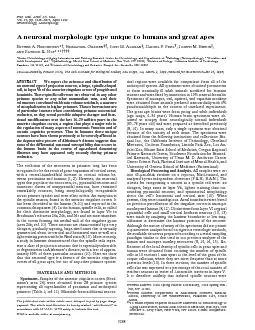

Theevolutionoftheneocortexinprimateslonghasbeenrecognizedtobetheresultofgreatexpansionofcorticalareaswithaseveralhundredfoldincreaseincorticalvolumebetweenprosimiansandhumans12Howevertheneuron ID: 176520
Download Pdf The PPT/PDF document "Proc.Natl.Acad.Sci.USAVol.96,pp.5268" is the property of its rightful owner. Permission is granted to download and print the materials on this web site for personal, non-commercial use only, and to display it on your personal computer provided you do not modify the materials and that you retain all copyright notices contained in the materials. By downloading content from our website, you accept the terms of this agreement.
Proc.Natl.Acad.Sci.USAVol.96,pp.5268±5273,April1999Neurobiology,AnthropologyAneuronalmorphologictypeuniquetohumansandgreatapesA.NM.AANIELP.PM.ERWINR.H*KastorNeurobiologyofAgingLaboratoriesandFishbergResearchCenterforNeurobiology,andDepartmentsofPathology(Neuropathology),**GeriatricsandAdultDevelopment,andOphthalmology,MountSinaiSchoolofMedicine,NewYork,NY10029;DivisionofBiology,CaliforniaInstituteofTechnology,Pasadena,CA91125;andDivisionofNeurobiologyandBehavior,BioqualInc.,Rockville,MD20850CommunicatedbyFrancisCrick,TheSalkInstituteforBiologicalStudies,SanDiego,CA,March1,1999(receivedforreviewNovember16,1998)ABSTRACTWereporttheexistenceanddistributionofanunusualtypeofprojectionneuron,alarge,spindle-shapedcell,inlayerVboftheanteriorcingulatecortexofpongidsandhominids.Thesespindlecellswerenotobservedinanyotherprimatespeciesoranyothermammaliantaxa,andtheirvolumewascorrelatedwithbrainvolumeresiduals,ameasureofencephalizationinhigherprimates.Theseobservationsareofparticularinterestwhenconsideringprimateneocorticalevolution,astheyrevealpossibleadaptivechangesandfunc-tionalmodificationsoverthelast15±20millionyearsintheanteriorcingulatecortex,aregionthatplaysamajorroleintheregulationofmanyaspectsofautonomicfunctionandofcertaincognitiveprocesses.ThatinhumanstheseuniqueneuronshavebeenshownpreviouslytobeseverelyaffectedinthedegenerativeprocessofAlzheimer'sdiseasesuggeststhatsomeofthedifferentialneuronalsusceptibilitythatoccursinthehumanbraininthecourseofage-relateddementingillnessesmayhaveappearedonlyrecentlyduringprimate Theevolutionoftheneocortexinprimateslonghasbeenrecognizedtobetheresultofgreatexpansionofcorticalareas,withaseveral-hundredfoldincreaseincorticalvolumebe-tweenprosimiansandhumans(1,2).However,theneuronaltypesthatpopulatetheneocortex,i.e.,pyramidalneuronsandnumerousclassesofnonpyramidalneurons,haveremainedremarkablyconstant,beingmorphologicallyrecognizableacrossprimatespeciesandevenotherorders.Anexceptionisthespindleneuron,foundintheanteriorcingulatecortex.Ithasbeendescribedinthehuman(3±10)andreportedinthecommonchimpanzee(6).Inthehuman,spindlecells,socalledfortheirdistinctivemorphology,arefoundinlayerVbinBrodmann'ssubareas24a,24b,and24candaremostabundantinthecortexformingthemedialwallofthecingulategyrus(area24b;ref.10).Theseneuronsarecharacterizedbyaveryelongate,graduallytapering,large-sizedsomathatisvirtuallysymmetricalaboutitsverticalandhorizontalaxesaswellasalightstainingpatternwiththeNisslstain(8,10).Morerecently,astudyinhumansdemonstratedthatthespindlecellsrepre-sentaclassofprojectionneuronsthatisespeciallyvulnerabletodegenerationinAlzheimer'sdisease,withalossofapprox-imately60%oftheseparticularneurons(10).Hereweshowthatthisneuronaltypeisafeatureoftheanteriorcingulatecortexofallgreatapes,butnotofanyotherprimatespecies.MATERIALSANDMETHODSSamplesoftheanteriorcingulatecortex(Brod-mann'sarea24)wereobtainedfrom28primatespeciesrepresentingallsuperfamiliesofprosimianandanthropoidprimates(Table1;ref.11).Materialsfromadditionalneocor-ticalregionswereavailableforcomparisonfromalloftheanthropoidspecies.Allspecimenswereobtainedpostmortemorfromterminallyilladultanimalssacrificedforhumanereasonsandwerefixedbyimmersionin10%neutralformalin.Specimensofmacaque,owl,squirrel,andcapuchinmonkeyswereobtainedfromanimalsperfusedtranscardiallywith4%paraformaldehydeinthecontextofunrelatedexperiments.Thegreatapebrainswerefromyoungandadultindividuals(agerange,4±34years).Humanbrainspecimenswereob-tainedatautopsyfromneurologicallynormalindividuals(65±78yearsold)andwerepreparedasdescribedpreviously(8,10).Inmanycases,onlyasinglespecimenwasobtainedbecauseofthescarcityofsuchtissue.Thespecimenswereobtainedfromthefollowinginstitutionsandcollections:Bio-qualInc.,theCaliforniaInstituteofTechnology,ClevelandMetrozoo,CoulstonFoundation,LincolnParkZoo,LosAn-gelesZoo,MountSinaiSchoolofMedicine,OregonRegionalPrimateResearchCenter,SouthwestFoundationforBiomed-icalResearch,UniversityofTexasM.D.AndersonCancerCenterSciencePark,NationalInstituteofMentalHealth,andUniversityofGenevaSchoolofMedicine(Switzerland).HistologicalProcessingandAnalysis.Allsampleswerecutinto40-m-thicksectionsonacryostat,Nissl-stained,andanalyzedbytwoindependentobservers(P.R.H.,E.A.N.).Thecriteriaforcategorizinganeuronasaspindlecellwere:anelongate,largesomainlayerVb,lighterstainingthansur-roundingpyramidalneurons,andsymmetricalmorphologyaboutthecell'shorizontalandverticalaxes(10).Whenpresent,theywereunambiguous.Arealboundarieswerebasedonpreviousparcellationsofthecingulatecortexinmacaquemonkeyandhuman(8,12).DistinctionsfromlayerVIatypicalpyramidalcellsandsmallverticalfusiformneurons(10,13)weremadebyanalyzingthelaminarboundariesatlowmag-nificationtodeterminethelaminarpositionoftheneurons.Althoughthenatureofmanyofthespecimensdidnotpermitaquantitativeanalysisbasedonrigorousstereologicmethods,theavailabletissuewaspreparedaccordingtoaserialsamplingparadigmsimilartothatusedinourpreviousanalysesofthehumanandmacaquemonkeyneocortex(8,10,14,15).Re-flectionsofthelocaldensityofspindlecellsingreatapesandhumanwereobtainedfromcountingthenumberofspindlecellsin10sections1mmapartatthelevelofthegenuofthecorpuscallosum,wheretheyaremorefrequentthanatmoreposteriorlevels(10).Inthesesections,thenumberofspindlecellsalsowasexpressedasapercentageofthetotalnumberofresidentneuronsinseriesof1-mm-widetraversesinlayerV.Itisthereforeunlikelythatisolatedspindleneuronswere Thepublicationcostsofthisarticleweredefrayedinpartbypagechargepayment.Thisarticlemustthereforebeherebymarked``advertisement''inaccordancewith18U.S.C.§1734solelytoindicatethisfact.PNASisavailableonlineatwww.pnas.org. Presentaddress:ColdSpringHarborLaboratory,ColdSpringHar-bor,NY11724.Presentaddress:DepartmentofAnatomicalSciences,MedicalSchool,UniversityoftheWitwatersrand,Parktown2193,SouthAfrica.Towhomreprintrequestsshouldbeaddressedat:NeurobiologyofAgingLaboratories,MountSinaiSchoolofMedicine,Box1639,OneGustaveL.LevyPlace,NewYork,NY10029.e-mail:hof@neuro. overlookedinprosimians,OldandNewWorldmonkeys,andlesserapes.Representativemapsofspindlecelllocationwerepreparedfromeachsamplebyusingacomputer-assistedimage-analysissystemconsistingofaZeissAxiophotphotomi-croscopeequippedwithaZeissMSP65computer-controlledmotorizedstage,aZeissZVS-47Evideocamera,aMacintosh840AVmicrocomputer,and,acustom-designedsoftwareformorphologyandstereology(16).Toproducethesemaps,thecoordinatesofeachlabeledelementwererecordedineachmicroscopicfield,typicallyafractionofacorticallayerata20magnification,relativetoanorigin,andthemapswereassembledautomatically.Thedegreeofran-domness()ofthelaminardistributionofspindlecellswasassessedfurtherbyrelatingtheirmeannearest-neighbordis-tancetotheirmeandensityasdescribedbyMorrisonetal.Withthismethod,if1thedistributionisrandom,if1itisclustered,andif1itisnonrandom(17).Stereologicestimatesofindividualneuronalvolumeswereperformedat100byusingtherotatorprotocolinsoftware(16,18).Theseneuronalvolumeswerecomparedwithrelativebrainvolumebycalculatingthelinearregressionofestimatedbrainvolumevs.bodyweightforadatasetincludinghumans,apes,andmonkeys.Thebrainresidualsareameasureofencephalizationwithinanthropoidprimates(19,20).Statisti-calanalysiswasdonebyusingaone-wayANOVAandpost-hoctestandtestsofcorrelation.RESULTSInthehumananteriorcingulatecortex,spindlecellsoccurmostofteninclustersofthreetosixneurons(Fig.1),arelocatedexclusivelyinlayerVb,andareconspicuousbecauseoftheotherwiselowcellulardensityofthislayer(10).Inthebonobo,thedistributionofspindlecellsmostcloselyresembledthatseeninhumans,withclearclustersfoundthroughoutlayerVbofarea24(Fig.1).Thecommonchimpanzeehadabundantspindlecells,buttheyweremorelikelytobefoundsinglyoringroupsoftwotothreeneurons(Fig.1).Inthegorilla(Fig.1),theoveralldistributionresembledthatinthecommonchimpanzee,butthespindlecellswereconsiderablylessabundant.Intheorangutan(Fig.1),spindlecellswereevidentbutobservedonlyoccasionally.Spindlecellswerenotablyabsentinthegibbon(Fig.1),aswellasinNewWorldmonkeys(e.g.,CallithrixSaimiri,and),OldWorldmonkeys(e.g.,Erythrocebus,and),andalloftheprosimians(Fig.1;Table1).Nearest-neighboranalysisrevealedthatspindlecellsaredistributedregularlyinlayerVbinorangutan,gorilla,andcommonchimpanzeewithvaluesof2.11,1.74,and1.28,respectively.Theirdistributionwasmarkedlyclusteredinbonobo(0.80)andhumans(0.40;Fig.2).Semiquantitativeesti-matesoflocalnumbersofspindlecellsrevealed7±10spindleneuronsinthesectionsfromtheorangutanspecimen,21.95.4(meannumberpersectionSD)ingorillas,37.19.4incommonchimpanzees,60±75inthebonobospecimen,and14.6inhumans.Spindlecellnumbersaccountedfor0.6%inorangutan,2.3%ingorilla,3.8%incommonchim-panzee,4.8%inbonobo,and5.6%inhumansofthenumberofpyramidalcellsinlayerVtraverses,furtherdemonstratingtheirrarity(Figs.2and3).Thesedatawereobtainedfrom4-to34-year-oldapes,sobrainagingisveryunlikelytohaveplayedaroleinthelownumbersoftheseneuronsinthesespecimens,andnormalbrainagingisknowntoinduceonlyaverymarginallossofneuronsinhuman(21).Qualitativeassessmentsofspindlecelldensitiesanddistributiononsec-tionsatlevelsrostralandcaudaltothegenuofthecorpuscallosumshowapatterncomparabletothatpreviouslyde-scribedinthehumananteriorcingulatecortex(10),indicatingthatitrepresentsavalidsamplingpointforcomparisonacrossspecies(Fig.3).Stereologicvolumeestimatesindicatethatspindlecellswere,onaverage,largerthanneighboringlayerVpyramidalcellsandconsiderablylargerthanthesmallfusiformneuronsoflayerVI(Table2).Thesevolumetricdataalsodemonstratethatspindlecellswerelargerinchimpanzeesandhumansthaningorillasandorangutans,whereasthetwoothercelltypeshadcomparablevolumesacrossspecies(Table2).Furthermore,whencomparingneuronalvolumeswithrelativebrainvolumes(19,20),weobservedthatthevolumeofspindlecellsiscorrelatedstronglytoencephalization,assessedbycalculatingbrainresiduals(0.001;Fig.4),whereasthevolumesoflayerVpyramidalneuronsandlayerVIsmallTable1.Summaryoftheprimatespeciesinvestigated TaxonomySpindlecellsEulemurfulvusNone1LemurcattaNone1PropithecusverreauxiNone1CheirogaleusmediusNone1MicrocebusmurinusNone1LoroideaGalagonidaeGalagosenegalensisNone1GalagoidesdemidoffNone1LorisidaeLoristardigradusNone1NycticebuscoucangNone1PerodicticuspottoNone1TarsiussyrichtaNone1AnthropoideaCallithrixjacchusNone2AotustrivirgatusNone2CebusapellaNone4SaimirisciureusNone1CercopithecoideaCercopithecidaeMacacafascicularisNone8MacacafuscataNone4MacacamulattaNone4MacacanemestrinaNone4MacacanigraNone4ErythrocebuspatasNone4PapiohamadryascynocephalusNone1HylobateslarNone4PongidaePongopygmaeusRare1GorillagorillagorillaFrequent5PantroglodytesAbundant8Panpaniscusclusters1Homosapiensclusters6Taxonomicpositionoftheprimatespeciesinvestigatedwithintheirfamilies,superfamilies,andsuborders(11).SpindlecellsinlayerVbofanteriorcingulatecortexarea24areobservedwithcertaintyonlyamonghominoids,inallextantpongidandhominidspecies(shownin,numberofavailablespecimensineachspecies.Neurobiology,Anthropology:Nimchinskyetal.Proc.Natl.Acad.Sci.USA96(1999) fusiformcellsarenot(0.196and0.33,respectively).Thepresentseriesspansalloftheprimatesuperfamilies,althoughitlacksrepresentativesofseveralfamiliessuchaslargeceboids,colobinemonkeys,guenons,andthesiamang.However,giventhelackofspindlecellsin23primatefamilies,aswellinalloftheothermammalswestudied(22),theparallelemergenceofthiscelltypeinanotherprimateseemsunlikely.Infact,samplesfromtheanteriorcingulate(oranteriormedial)cortexandseveralotherneocorticalregionsofmore .2.High-magnificationcomputer-generatedmapsofthelocalizationofspindleneuronsinlayersVoftheanteriorcingulatecortexinorangutan(),gorilla(),commonchimpanzee(),bonobo(),andhuman().Spindlecellsarerepresentedbysolidmarks,andtheneighboringpyramidalneuronsarerepresentedbyopentriangles.Notethedifferencesinthedensitiesoftheseneuronsamongspeciesandtheclusteredpatterninbonoboandhuman.are1-mmwideandare1.5-mmwide. .1.MorphologyofspindlecellsinlayerVboftheanteriorcingulatecortexinhuman(),bonobo(),commonchimpanzee(),gorilla),andorangutan().Inallofthesespeciesthespindlecellsdisplaysimilarmorphologyandapparentsomaticsize.Notetheclustersofspindlecellsinthethrough-focusphotomontagefromthehumanandinthebonobo,whereasisolatedneuronsareobservedinthethreeothergreatapes.)Nospindlecellsarepresentintheanteriorcingulatecortexofthewhite-handedgibbon(),Patasmonkey(),orring-tailedlemur((550mm(A),80),and1205270Neurobiology,Anthropology:Nimchinskyetal.Proc.Natl.Acad.Sci.USA96(1999) than30othermammalianspecies,includingmonotremes,marsupials,insectivores,micro-andmegachiropterans,ro-dents,carnivores,artiodactyls,andcetaceans,wereanalyzed(22),andspindlecellswerenotfoundinanyofthem.Spindlecellsarealsofound,albeitinmuchlowernumbers,intheanterior,agranular,anddysgranularportionsoftheinsularcortexofthehuman,butnotthemacaquemonkey(5,8±10,23).Unfortunately,samplesofinsularcortexwerenotavail-ableforthepresentstudyfrommostofthespeciesstudied,althoughfromthelimitednumberofsampleswedidobtain,itappearsthatsomespindlecellsalsoarefoundintheagranularinsulaofgreatapes.Spindlecellswereneverobservedinanyotherneocorticalareasinalloftheavailableprimatespecies.Theforegoingsuggeststheveryrare,ifnotunprecedented,emergenceofaunique,morphologictypeofprojectionneu-ron,madeallthemoreremarkablebyitsrestrictiontoaverydiscretecorticalregionandaverysmallbuthighlysignificantgroupofspecies.Fromaphylogeneticstandpoint,theobser-vationthatamonghumansandgreatapes,chimpanzeeshavespindlecelldensitiescomparabletohumansÐanditisthebonobowhosespindlecelldistributionmostcloselymatchesTable2.VolumesoflayerVspindleandpyramidalcellsandsmall-layerVIfusiformcells SpeciesPyramidalcellsSpindlecellsFusiformcellsP.pygmaeus9136,648G.g.gorilla1,2955,684P.troglodytes1,1988,796P.paniscus1,8597,743H.sapiens2,29520,822Volumetricdata()wereestimatedinasampleof50neuronsineachlayerfromeachcasebyusingtherotator(18)andareexpressedasmeansSD.Notethat,inspiteofhighvariability,thevolumeofspindlecellstendstobegenerallyhigherthanthatoflayerVpyramidalcells(0.05)andsmall-layerVIfusiformneurons(²,andthatspindlecellsarelargerinand,particularly,incomparedwithGorilla .3.Computer-generatedmapsofthedistributionofspindleneuronsintheanteriorcingulatecortex.Allmapsshowalevelsituatedatthegenuofthecorpuscallosuminthehuman(),bonobo(),commonchimpanzee(),gorilla(),andorangutan().ThespindlecellsarerestrictedtolayerVbandshowmuchhighernumbersinhumanandthetwochimpanzeespecies,whereasfewerareseeningorillaandorangutan.Nospindlecellsareobservedinthewhite-handedgibbon(),long-tailedmacaquemonkey(),andowlmonkey().Themapsareapproximatelytoscale.Thedarklyshadedareasinreflectlocaldamagetothesuperficiallayersofthespecimen.Thecaudatenucleusisshadeddarklyin.CC,corpuscallosum;CS,cingulatesulcus.Neurobiology,Anthropology:Nimchinskyetal.Proc.Natl.Acad.Sci.USA96(1999) thatofthehumanÐunderscorestherelatednessofandoffersaneuroanatomicalcorrelatetothegroupingofthesetaxainthesameclade,acontentionthatissupportedbymolecularbiologicalandmorphologicaldata(24±27).More-over,inviewofdataindicatingthatneuronsformingdefinedprojectionstendtobeclusteredinthecortex(28),themorepronouncedgroupingofspindlecellsinsuggestiveoftheemergenceandprogressiveanatomicalre-finementofahighlyspecificpathwayinhominids,whichbegantoemergeinthecommonancestorofpongidsandhominidsandisparticularlywelldevelopedinThenatureoftheavailablematerialprecludesthephysio-logicalandconnectionalstudiesthatcouldhelpelucidatetheroleofspindlecells.However,existingdataonthecorticalareatowhichtheyarerestrictedmightprovidecluestotheirfunction.Itisalsoworthremarkingthatthedensityofspindlecellsismarkedlyreducedpreciselyinthetransitionareabetweenanteriorandposteriorcingulatecortex(aregiontermedarea24inhumans;refs.8and29),whichcorrespondstotheregionsthatcontainthecingulatemotorareasinmacaquemonkeys(30±33),suggestingthatthedistributionofspindlecellsdoesnotoverlapwithregionsofthecingulatecortexinvolvedinsomaticmotorfunction.Infact,thecingu-latemotorareasinhumanshavewelldefinedcyto-andchemoarchitecturalpatterns(8,29,34)andarelocatedcau-dallyanddorsallytotheregioninwhichspindlecellsaredistributed.Althoughexhaustivesamplesseldomareavailable,preventingproperstereologicestimatesofthenumberoftheseneurons,theyconstituteasmallfractionofthecorticalpyra-midalneuronpopulation(10).Theycould,however,representadiscreteprojection,reminiscentoftheMeynertneuronsoftheprimaryvisualcortex(35,36)ortheBetzcellsintheprimarymotorcortex(37),ofprimates.Alternatively,theemergenceofamorphologictypecouldbemerelyaninciden-talconsequenceofvigorousadaptivechanges.Eitherinter-pretation,however,wouldsuggestthattheanteriorcingulatecortexmayhavebeensubjectedtounusualadaptivepressureoverthelast15±20millionyears.Theanteriorcingulatecortexisregardedasaphylogeneti-callyancientarea(38).Itsubservesmanyfunctionsthatmayvaryacrossspecies,althoughitsroleincorticalcontrolofautonomicfunctions,suchasheartrate,bloodpressure,anddigestivefunctions(39±43),appearstobewellconserved.Alongtheselines,area24inmacaquesisinterconnectedwiththeamygdalaandhasbeenshowntohavelayerVprojectionstothehypothalamusandtheperiaqueductalgray(43±45).Fromthisperspective,thespindlecellsoftheanteriorcingu-latecortexmightrepresentapopulationofspecializedneuronsthatcouldintegrateinputswithemotionalovertonesandprojecttohighlyspecificmotorcenterscontrollingvocaliza-tion,facialexpression,orautonomicfunction.Inaddition,thepresenceofatleastsomespindlecellsintheanteriorportionoftheinsulasupportsthenotionoftheirroleinautonomiccontrol,becausethisregionalsoisknowntobeinvolvedintheregulationofvisceral,olfactory,andgustatoryfunctions,aswellascomplexalimentarybehaviors(46±49).However,inhumanstheanteriorcingulatecortexalsoappearstobeinvolvedinhigher-levelprocessesthatareresponsibleformorethanmerelysensoryinputormotoroutput.Recentfunctionalimagingstudieshavedemonstratedanimportantroleforthedorsalhumananteriorcingulatecortexinattention,withitsdegreeofactivationincreasingwithtaskdifficulty,andthemoreventralportionintheexperienceofthe``unpleasantness''ofpainandintherecognitionoftheemotionalcontentoffaces(43,50,51).Thus,inhumans,atleast,theanteriorcingulatecortexisinvolvedincomplexprocessesthatassistinintegra-tionandinterpretationofsensoryinformation.Inthiscontext,theuniquecorrelationamongtheresidentneuronsoflayersVandVIofthecellularvolumeofspindlecellswithenceph-alizationinhumanandgreatapeslendsfurthersupporttothepossibleassociationofspindlecellswithhighercorticalfunc-tioning.Interestingly,lesionsintheanteriorcingulatecortexinhumanareassociatedwithaformofmutism(43,52,53),andtheareatowhichthespindlecellsarerestrictedisoneoftheonlycorticalareasknowntoelicitmeaningfulvocalizations(andnotmerelysounds)insquirrelmonkeyswhenstimulated(54,55).Ithasalsobeenshowntoparticipateinvoluntaryphonationinmacaquemonkeys(56).Thus,thisregionmaybeinvolvedinsomeaspectsofcommunicationinprimates,anditispossiblethattheappearanceofthesemodifiedpyramidalneuronsmightsignalthefurtheranatomicandpossiblyfunc-tionalelaborationofthiscorticalareaintheonlymammalianlineageknowntohaveevolvedspeechanditsemotionalimplications.Itisalsoworthnotingthattheemergenceofthisuniqueneuronaltypeinaneocorticalareainvolvedinvocal-izationinprimatescoincideswiththeevolutionasadefinableanatomicstructureoftheplanumtemporale,aregionthatisimportantforlanguagecomprehension(57,58).Inviewofthelanguagecomprehensionabilitiesofgreatapes(59),itisthereforepossiblethatseveralcorticalstructuresinvolvedintheproductionofspecificvocalizationsandincommunicativeskillssustainedsimultaneous,considerable,adaptivemodifi-cationsduringbrainevolutioninhominoids.Finally,takentogetherwithourearlierfindingthatspindlecellsinthehumanapparentlyaremorevulnerabletoneuro-degenerationinAlzheimer'sdiseasethanotherpyramidalneurons,possiblyowingtotheirhighcontentofneurofilamentprotein(10,21),thepresentstudypointsoutsomeofthepossiblelimitationsofmakingcomparisonsbetweenhumansandmoredistantlyrelatednonhumanprimatesandempha-sizestheimportanceofthestudyofgreatapesinthecontextofagingandofage-relateddiseasesaffectingthecerebralcortex.Suchknowledgemightassistinourunderstandingofthepossiblyphylogeneticbasisofdifferentialneuronalvul-nerability(60)andofsomeofthemostdevastatingneurologicandpsychiatricillnessesfromwhichourownspeciessuffers.WethankDrs.C.Bouras,I.I.Glezer,S.G.Kohama,J.Marcus,E.J.Mufson,andL.G.Ungerleiderforprovidingsomeofthespecimens;Dr.T.InselforprovidingadatasetonbonobobrainvolumeandA.Hakeemforhelpwithdataanalysis;Drs.P.J.Gannon,C.V.Mobbs,J.H.Morrison,P.R.Rapp,andB.A.Vogtforhelpfuldiscussions;Dr.W.G.Youngforsoftwaredevelopment;andS.Bruns,A.P.Leonard,E.Lugo,F.Robenzadeh,andR.Vertesifortechnicalassistance.MostofthegreatapebrainsweresuppliedbytheGreatApeAgingProject,acomparativeneurobiologyofagingresourceatBioqualInc.(J.M.E.).ThisworkwassupportedbyNationalInstitutesofHealthGrantsAG14308(J.M.E.),CAMH08944,andEY11759(J.M.A.),theDelWebbFoundation(E.G.),andMountSinaiSchoolofMedicine .4.Comparisonofspindlecellvolumewithrelativebrainvolume(seerefs.19and20).Thereisastrongcorrelationbetweenthevolumesoftheseneuronsandbrainvolumeresiduals.NosuchcorrelationexistedforpyramidalandsmallfusiformneuronsoflayersVandVI.5272Neurobiology,Anthropology:Nimchinskyetal.Proc.Natl.Acad.Sci.USA96(1999) 1.Frahm,H.D.,Stephan,H.&Stephan,M.(1982)J.Hirnforsch.2.Dunbar,R.I.M.(1998)Evol.Anthropol.178±190.3.Betz,W.(1881)Zentralbl.Med.Wiss.193±195,209±213,4.Hammarberg,C.(1895)StudienuÈberKlinikundPathologiederIdiotienebstUntersuchungenuÈberdienormaleAnatomiedesHirnrinde(Berling,Uppsala).5.RamoÂnyCajal,S.(1899)TexturadelSistemaNerviosodelHombreydelosVertebrados,TomoII(NicolaÂsMoya,Madrid).6.Rose,M.(1927)J.Psychol.Neurol.7.DeCrinis,M.(1933)J.Psychol.Neurol.439±449.8.Vogt,B.A.,Nimchinsky,E.A.,Vogt,L.J.&Hof,P.R.(1995)J.Comp.Neurol.490±506.9.VonEconomo,C.(1926)Zschr.Ges.Neurol.Psychiat.706±712.10.Nimchinsky,E.A.,Vogt,B.A.,Morrison,J.H.&Hof,P.R.J.Comp.Neurol.11.Rowe,N.(1996)ThePictorialGuidetotheLivingPrimates(PogoniasPress,EastHampton,NY).12.Vogt,B.A.,Pandya,D.N.&Rosene,D.L.(1987)J.Comp.Neurol.256±270.13.ToÈmboÈl,T.(1984)inCerebralCortex,CellularComponentsoftheCerebralCortex,eds.Peters,A.&Jones,E.G.(Plenum,NewYork),Vol.1,pp.479±519.14.Hof,P.R.&MorrisonJ.H.(1995)J.Comp.Neurol.15.Hof,P.R.,Mufson,E.J.&Morrison,J.H.(1995)J.Comp.Neurol.48±68.16.Bloom,F.E.,Young,W.G.,Nimchinsky,E.A.,Hof,P.R.&Morrison,J.H.(1997)inNeuroinformaticsÐAnOverviewoftheHumanBrainProject,eds.Koslow,S.H.&Huerta,M.F.(LawrenceErlbaum,Mahwah,NJ),pp.83±123.17.Morrison,J.H.,Magistretti,P.J.&Bloom,F.E.(1984)269±282.18.Vedel-Jensen,E.B.&Gundersen,H.J.G.(1993)J.Microsc.35±44.19.Allman,J.M.,McLaughlin,T.&Hakeem,A.(1993)Proc.Natl.Acad.Sci.USA118±122.20.Allman,J.M.,McLaughlin,T.&Hakeem,A.(1993)Proc.Natl.Acad.Sci.USA3359±3363.21.Morrison,J.H.&Hof,P.R.(1997)412±419.22.Hof,P.R.,Glezer,I.I.,CondeÂ,F.,Flagg,R.A.,Rubin,M.B.,Nimchinsky,E.A.&VogtWeisenhorn,D.M.(1999)J.Chem.Neuroanat.23.Ngowyang,G.(1932)J.Psychol.Neurol.671±674.24.Arnason,U.,Xu,X.,Gullberg,A.&Graur,D.(1996)J.Mol.Evol.41±45.25.Barriel,V.(1997)FoliaPrimatol.50±56.26.Ruvolo,M.(1997)Mol.Biol.Evol.248±265.27.Begun,D.R.(1992)1929±1933.28.Hiorns,W.,Neal,J.W.,Pearson,R.C.A.&Powell,T.P.S.Proc.R.Soc.LondonSer.B29.Nimchinsky,E.A.,Vogt,B.A.,Morrison,J.H.&Hof,P.R.J.Comp.Neurol.597±620.30.Muakkassa,K.F.&Strick,P.L.(1979)BrainRes.176±182.31.Dum,R.P.&Strick,P.L.(1993)inNeurobiologyofCingulateCortexandLimbicThalamus,eds.Vogt,B.A.&Gabriel,M.(Birkhauser,Basel),pp.415±441.32.Morecraft,R.J.&VanHoesen,G.W.(1992)J.Comp.Neurol.471±489.33.Nimchinsky,E.A.,Hof,P.R.,Young,W.G.&Morrison,J.H.J.Comp.Neurol.136±160.34.Braak,H.(1976)BrainRes.219±233.35.Spatz,W.B.(1975)BrainRes.450±455.36.Fries,W.,Keizer,K.&Kuypers,H.G.J.M.(1985)Exp.Brain613±616.37.Scheibel,M.E.&Scheibel,A.B.(1978)inArchitectonicsoftheCerebralCortex,eds.Brazier,M.A.B.&Petsche,H.(Raven,NewYork),pp.43±57.38.Sanides,F.(1969)Ann.N.Y.Acad.Sci.404±423.39.Kaada,B.,Pribram,K.H.&Epstein,J.(1949)J.Neurophysiol.40.Pool,J.L.&Ransohoff,J.(1949)J.Neurophysiol.41.Showers,M.J.C.&Crosby,E.C.(1958)Neurology42.Showers,M.J.(1959)J.Comp.Neurol.43.Devinsky,O.,Morrell,M.J.&Vogt,B.A.(1995)279±306.44.An,X.,Bandler,R.,OÈr,D.&Price,J.L.(1998)J.Comp.Neurol.455±479.45.OÈr,D.,An,X.&Price,J.L.(1998)J.Comp.Neurol.480±505.46.Penfield,W.&Faulk,M.E.(1955)445±470.47.Showers,M.J.C.&Lauer,E.W.(1961)J.Comp.Neurol.48.Mesulam,M.M.&Mufson,E.J.(1985)inCerebralCortex,AssociationandAuditoryCortices,eds.Peters,A.&Jones,E.G.(Plenum,NewYork),Vol.4,pp.179±226.49.Oppenheimer,S.M.,Gelb,A.,Girvin,J.P.,Hachinski,V.C.Neurology50.Rainville,P.,Duncan,G.H.,Price,D.D.,Carrier,B.&Bushnell,M.C.(1997)968±971.51.Paus,T.,Koski,L.,Caramanos,Z.&Westbury,C.(1998)NeuroReport52.Barris,R.W.&Schuman,H.R.(1953)Neurology44±52.53.Nemeth,G.,Hegedus,K.&Molnar,L.(1988)Eur.Arch.PsychiatryNeurol.Sci.218±222.54.JuÈrgens,U.&Ploog,D.(1970)Exp.BrainRes.55.JuÈrgens,U.(1998)376±388.56.Trachy,R.E.,Sutton,D.&Lindeman,R.C.(1981)Am.J.Primatol.57.Gannon,P.J.,Holloway,R.L.,Broadfield,D.C.&Braun,A.R.220±222.58.Hopkins,W.D.,Marino,L.,Rilling,J.K.&McGregor,L.A.NeuroReport59.Savage-Rumbaugh,E.S.(1986)ApeLanguage:FromConditionedResponsetoSymbol(ColumbiaUniv.Press,NewYork).60.Rapoport,S.I.(1990)BrainRes.Rev.Neurobiology,Anthropology:Nimchinskyetal.Proc.Natl.Acad.Sci.USA96(1999)